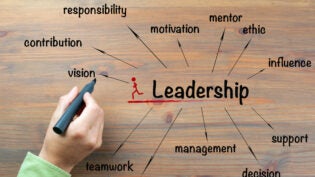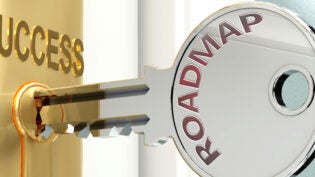
A great leader knows that balancing your leadership style is the difference between warmth and strength. If it’s time for you to conduct an honest assessment of your leadership style to connect better with your teams and understand your stakeholders more effectively, take a listen to hear how to connect, then lead.
In this Manage This podcast transcript, we explore topics, such as snap judgements, first impressions, verbal and non-verbal cues, communicating ideas to a highly skilled group of people, and speaking truth to those in positions of power. You can listen to the full episode here or read on:
MATT KOHUT: Some people tend to go with their strength first, and they backfill on the warmth. Some people lead with warmth first, and they backfill on the strength. And it’s sort of like being left-handed or right-handed. Everybody’s just got a dominant hand. And as long as you can pick up objects with both of them and not drop them, it’s okay.
WENDY GROUNDS: You’re listening to Manage This, the podcast by project managers for project managers. My name is Wendy Grounds, and with me in the studio is Bill Yates and Danny Brewer. We love having you join us twice a month to be motivated and inspired by project stories, leadership lessons, and advice from industry experts from all around the world. Our aim is to bring you some support as you navigate your projects.
Today we’re talking to Matt Kohut. Matt is a co-founder of KNP Communications, and he has 20 years of professional experience writing and preparing speakers for both general and expert audience. In addition, he has served as a communications consultant to organizations including NASA, the Department of Energy, the Environmental Protection Agency, and Harvard University.
Matt is currently a fellow at the Center for Advancement of Public Action at Bennington College, and he’s previously worked at Harvard University as research specialist to the dean of Kennedy School. Now, this is an interesting conversation, and we are very excited to bring it to you because it follows on so well to our conversation we had with Vanessa Druskat on emotional intelligence.
BILL YATES: Yes, this is an area that I think because of my own experience, I feel like this is an area that a project manager, certainly me, should and can grow in throughout their career. It’s amazing talking with Matt. He knows so much about social science. That’s the background experience he has. But the advice that he gives is so practical. Not only did he write speeches, he coached those who were delivering the speeches as to how to make a good first impression, how to connect with their audience, how to not overpower them with too much information.
These are things that project managers struggle with. These are things that we have to be aware of. So the advice that Matt gives in our conversation is really going to help us be better at our jobs, connect better with our teams, understand our customers better, and amp up our performance.
WENDY GROUNDS: Hi, Matt. Welcome to Manage This. Thank you for being our guest today.
MATT KOHUT: Thanks for having me.
Balancing Your Leadership Style
WENDY GROUNDS: All right. Let’s jump into talking leadership and talking communication. One of the first things we wanted to talk about was there’s a difference between having social power and personal power. Those are two very different leadership terms. Can you define them for us?
MATT KOHUT: Well, social power, as the word “social” suggests, has to do with being with other people. And to a certain extent I think that it all comes down to the idea that, if you have power in a situation, ultimately you’re getting people to do something they might not otherwise do. And there are a lot of different ways to do this.
I’m actually a fan of an old boss of mine, a guy named Joseph Nye, who is an international relations theorist, a foreign policy expert. And he was the person who coined the terms “soft power” and “hard power.” And I actually find these really almost in some way the more interesting way to frame power. Hard power is coercing people, that is, you have to do this; and soft power is attracting people. And he always made the point that it’s much cheaper to attract people than to coerce them. They’re going to want to do what you want them to do, and they’ll do it even willingly.
And there are a variety of different ways you can do that if you’re a country thinking about trying to attract others to your agenda. But then I think it’s a really interesting metaphor for project managers and for anyone working in teams and professional settings, as well.
BILL YATES: Certainly. And there’s so much fallout when you do have to use hard power. It just doesn’t last, and especially if you want to keep your team together. And, “Okay, we had to push hard to finish something up. I’ll see you guys next week and we’ll start the next project.” Some of them are looking at you like, “No, you won’t. I’m out of here.”
MATT KOHUT: That’s right.
Knowing your Likeability
BILL YATES: There’s a big price. There’s a quote from an article that we wanted to reference with you. “Before people decide what they think of your message, they decide what they think of you.” It’s such a key to being an effective communicator, understanding how other people judge your character. So how important is likability, not only in terms of good leadership, but also when managing other project stakeholders?
MATT KOHUT: Well, there are a couple of things to that. I think that, first off, that point about the fact that people are judging your message through their feelings about you is really important, and that can have to do with likability. It can also have to do with their sense of your legitimacy or of your credibility, as well. So likability for sure matters. It’s one of the things that matters. There are other things that matter, as well.
So let’s just take the idea, though, first, of the importance of your message being filtered through how people feel about you. Right now we’re having a conversation. You’re figuring out how you feel about me at the same time you’re figuring out how you feel about my message. And you can’t really sort the two out. It’s not like our brains say, “Well, I dislike the person, but I like the message.” Generally speaking, it’s just not that conscious on our part. More often emotion leads, and logic follows.
And we feel some way, and then we make up a rationale for why we feel that way. It’s called “motivated reasoning” in the political world where people choose their candidate based on a gut sense, and then they come up with all these reasons why they think that person is the perfect person to be governor or dog catcher or whatever.
And that’s largely true about the way we interpret messages from people, too. We filter them through our feelings about the person. And sure, sometimes once we know someone, we can have some nuance about it and say, “Well, I really like him even though we disagree about X.” But by and large there’s a gray area there. So when you get to likeability, it’s a lot harder to disagree with someone you like. Think about this in your own life. You have good close friends, and then they say something. “Oh, my gosh, I can’t believe he just said that.” But it’s your friend and you like them. You don’t want to hurt their feelings.
So likeability makes you more influential with people, and that’s something that’s been proven time and again. One of the godfathers of influence, a guy named Robert Cialdini, has studied this. And it sounds self-evident, but likeability is a source of persuasion. And whether we like it or not, it does make a difference.
Strength and Warmth
WENDY GROUNDS: Yeah. That leads us into the next things about being a compelling leader. I watched your TED Talk, which is very good, and I recommend it to our audience. We’ll put a link in the transcript to that. What you talk about in the TED Talk is strength and warmth, and how that influences a leader. Can you talk a little bit more about that and the impact on leadership?
MATT KOHUT: Sure, yeah. This idea about strength and warmth was the basis of a whole book that my colleague John Neffinger and I wrote. And I’ll go into it, but I also want to just recognize that the idea was not ours alone. This really came out of a piece of academic work called “Social Judgment Theory” that was codified around 2007 by Amy Cuddy, Susan Fiske, and Peter Glick. John Neffinger and I stumbled on this because in our early work as coaches of public speakers we were finding that there were two common problems that people had: either people were extremely confident and competent, but they were cold as ice; or they were lovely people who were tripping over themselves with insecurities.
And we noticed this, and we were geeky people trying to find answers in social science, and social judgment theory spoke to this. What we found there we adapted slightly in that we realized that social judgment theory talks about competence and warmth, but in our experience competence doesn’t quite encompass the assertive dimension of what we later called strength, competence plus assertiveness. Think of this as skill plus will. It’s not enough just to know your stuff. You also have to be able to assert yourself and make your points. And so this idea of skill plus will equals strength is one of the judgments people make about us when they’re deciding if they want to listen to us, for instance. But it’s not the only one.
The other judgment, which goes to the point about likability earlier, is this idea of warmth. Now, “warmth” is a very loaded word on some way. It’s got a nurturing sense to it. The way I define it for people in professional settings is that it’s really an idea that someone understands your concerns. They understand your interests. They understand your emotions. It’s deeply related to empathy. I think a lot of times when you say the word “warmth,” people think we’re going to hold hands in a circle and sing “Kumbaya” or something. And it really doesn’t have to mean that in a professional setting. I often talk about it as connection because the word is a little more abstract, and everybody wants to be able to connect. You say “warmth” to a bunch of project managers, and you might get some sort of squirrelly looks from people.
Strength and Warmth Matrix
BILL YATES: Yeah, some funny looks. This is so key for me. You just mentioned how project managers perceive this. And I think project managers – and I’m speaking from my own experience. There are times when I’d walk into a room. My head was filled with the facts that I needed to cover in this meeting with important people. I had the right people in the room. I was very aware of, okay, it’s hard to get these people in the room, to get them to connect on one topic. Man, I’ve got to make the most of my time. So here’s my agenda.
And I’m coming in a bit strong, maybe not cold, but maybe extremely business-like. And I’m missing an opportunity. I’m unintentionally shutting people down. I’m not getting their best because I’m not setting up the right environment. And I love it that you build out a matrix of strength and warmth. And there’s a graph that you show, and you mention Darth Vader. So I just want you to talk a little bit about the strength and warmth, and talk a bit about that.
MATT KOHUT: Yeah. So your audience, you can imagine that if you have strength as your Y axis and warmth as your X – and you’ve got four quadrants. You’ve got two on one side, two on the other. And if you think about somebody who is high in strength, that is to say very capable, either they have a lot of skill, or they have a lot of will, or some combination of both of those things, but they’re not a people person. Think about your emotional response to that person if you’ve met them. Now, the Darth Vader response, if we think about Darth Vader as all strength, we hear the music change, and it literally inspires fear in us. Now, that’s a pretty strong reaction. Let’s acknowledge that.
When I think about it in a little bit more nuanced way, I’d break it down into people who you might think of as either overly assertive, bullies; or competence without any warmth, robots, people who are really good at the technical, but they’re a little bit divorced from the people. And so I think that what we tend to find is we have a feeling of coldness about this person. It might not rise to the level of Darth Vader fear, but there’s something that just doesn’t quite connect with us here. And then at the other extreme, you have the person who’s lovely. They’re great at human connection. But either they lack the competence, or they lack the ability to stand up for themselves.
And the two archetypes you’ve got here are the pushover and the lightweight. And we love these people, and we tend to want to protect them from what might happen to them out in the big bad world. We’re happy to have them be the greeter at the door, but we’re not necessarily going to give them the keys to the car. Again, I’m talking about the extremes of all warmth and really lacking in competence or assertiveness.
Changing Your Impact
BILL YATES: Okay, Matt. I’ve got to take a timeout right here and ask you, what advice do you have to that project manager who chuckled when you mentioned Darth Vader, but then sort of looked at himself and went, “Yeah, maybe that’s me.” So I’ve got a lot of strength. Maybe I come across too strong, and people don’t feel that connection. I can feel it. I walk into the room, and I can feel the impact I’m having, and I don’t really like it. How can I change?
MATT KOHUT: I think that all of us have a default. Some people tend to go with their strength first, and they backfill on the warmth. Some people lead with warmth first, and they backfill on the strength. And it’s sort of like being left-handed or right-handed. Everybody’s just got a dominant hand. And as long as you can pick up objects with both of them and not drop them, it’s okay.
Now, for the person who’s all strength and no warmth – and look, in a lot of engineering-based organizations that’s not uncommon. It’s part of the culture that we see often. One of the things to think about is that time spent on people is valuable time. And I think this is oftentimes a mindset challenge for the competence-first kind of project manager, or even the overly assertive project manager, is that the time you’re spending getting to know people, building relationships, is actually time that you’re going to reap rewards from. So part of it is thinking differently and developing a mindset of realizing, if I invest this time in people, it’s actually going to get me what I want.
So I think the first thing is just asking yourself to think differently about what it means to do a little bit of people work. And then the question becomes, not how do I smile more, or how do I put on some sort of a facade of likability, but how do I show an interest in these people? And I think if you can take the interest in someone, either by asking them questions in a curious way as opposed to an accusative way, if you can show that you understand either the pressure they’re up against or the difficulty of what they’re trying to do, show them some genuine appreciation for what they bring to the table, those are good starting places for trying to turn up the warmth in a way that is authentic for you.
Now, everybody’s different around this. Sometimes these aggressive project managers can also be great cheerleader types. Sometimes they almost have football coach rah-rah energy, and that might be their authentic way to access warmth. So I don’t want to overgeneralize about it, but it’s worth asking yourself, how can I either demonstrate an understanding of concerns, an understanding of interests, or an understanding of emotions? Which one of these is going to be easiest for me to jack into?
Make a Stronger Team Connection
BILL YATES: That’s good. And I think projects give us a unique opportunity to find common ground. You mentioned the team aspect and your music background. The group is finding we’ve got one piece of music that we want to master and deliver, or our project teams have a deliverable. They have something they’re creating that they all have the same goal in mind.
And I think someone who’s heavy on strength and not as strong on people, if they can think about, okay, who are the people that we’re impacting with our project? And I’ve probably already heard from some of them that maybe some of those team members that I’m about to go talk to have not. What feedback do I have from customers? You know, what am I hearing from the users?
And can I take some of that feedback and shine a light on some of the team members and actually make them think, oh wow, this guy, you know, he actually – maybe he cares. You know, he’s hearing from the customer. He’s even saying that I’ve done something good in the last week. Wow. You know, so I think there are connection points that come naturally with a project that we as leaders can tap into and maybe make that stronger team connection.
MATT KOHUT: That’s absolutely right. I was going to say, I knew a project manager who was at NASA years ago. He was a pretty senior person, and he made it his job to walk around and talk to the people who were the technical experts in different disciplines who he really didn’t necessarily have much insight about what they were doing. And he made it his business to find out what they were doing.
And sure enough, there was an instance with one of the projects that he was leading where there was a technical challenge that was hard to figure out how to approach it. Somebody working in the corner, a bit of an introvert, had come up with a technique that was going to actually be really critical to resolving this technical difficulty. And if he hadn’t been proactive about walking around, talking to people, trying to understand what made them tick and what they were doing over there in their 10% time and their little pet projects, they would have never found this thing. So I do think that this actually pays huge dividends for project managers, no matter how Type A you are.
How Not to Compromise Warmth
WENDY GROUNDS: Yeah, I want to turn it around now. If you’re someone who’s the warm side, and people tend to maybe think they’re more of a pushover, and they’re not exhibiting a strength. So how can you project strength, if you’re more the warmth type of leader without compromising the warmth?
BILL YATES: Well, you could get the Darth Vader mask and put it on.
WENDY GROUNDS: You could put the mask on. We’ve talked about masks in the past. Doesn’t always end well.
MATT KOHUT: You know, I think a lot of trying to dial up the assertiveness a little bit here is thinking about just being direct with people. I think a lot of times a warm person is trying not to hurt people’s feelings, and so there can be almost an allergy to directness. And when you’re framing an ask of somebody, or of a team, ask yourself, how much padding have I put around this? How much have I offered caveats and softeners and sweeteners? And how many of those words can I remove to make my statement more direct without it being offensive?
And if you strip it down to the real basics, then you can do a little bit of just damage control and say, “If I said this, what would happen?” rather than starting with an elaborately couched statement that people aren’t quite sure what you want them to do.
So rather than starting with all the qualifiers and caveats, strip them all out first and then add in the bare minimum of those things so that you’re not going to make an unforced error, but also going to be as direct as possible. I think sometimes it’s very surprising to people who struggle with this that they can be much more direct, and they’re not going to offend anyone. And they’re so conditioned to be overly polite in the way they approach things that it can be uncomfortable for them to just say, “We have to get this done by the end of the day.”
Snap Judgements and First Impressions
WENDY GROUNDS: Yeah, that’s good advice for working with stakeholders, as well. For a successful leader, perceptions are something that really do play a crucial role. People make snap judgments on us when they meet us. Sometimes it’s just that first impression, they’ve made that judgment, and that’s kind of it. So what happens in those first few moments when you meet someone, and they’re making those judgments, and how can you counteract that?
MATT KOHUT: You know, I’ve seen all the research on first impressions, and it’s very interesting, and you read these things about how it really happens in the blink of an eye. And there’s a lot to that – and. I think there’s an important “and” here because we all know someone we met who we thought, wow, he’s a real jerk. And then three weeks later we thought, you know, he’s actually got a heart of gold, or the opposite. And I think of the importance of this idea of first impressions almost like cement, where cement’s wet when you pour it, and over time it hardens. So I’m cautious about the idea that the first impression is everything.
But yes, it does matter, of course. I don’t want to diminish the fact that first impressions also do matter. And I think that we’re in a time where people really want to be authentic in their first impressions. They don’t want to put on an act. They don’t want to appear to be something that they’re not. And I think this comes with a little bit of a tension for people because there’s this question of I want to put my best foot forward, so to speak, and I want to be myself. I think for all of us there’s this question of how much authenticity do I want to bring to the table, and how much am I adaptable to my situation?
And all of us are ultimately adaptable. We’re not the same with our families as we are with our colleagues, as we are with people in our social groups, in our communities. And so I don’t buy the idea that there’s a single authentic any of us. We all have multiple selves here. And the question is, what’s our comfort zone with our authentic self at work? And to what extent are we willing to make adjustments to that, where it comes to trying to put forward the person who’s going to be most effective in the professional setting. That’s where I approach the question of snap judgments. I do realize I didn’t answer it directly.
Connect with Your Audience
BILL YATES: Matt, you’ve got such great experience, both, you know, I’m thinking of your passion for music and performance, the public speakers that you’ve worked with through the years, and the speech writing you’ve done. Take whichever angle you wish. But talk to us about some of the advice that you give people before, I’m just going to say before they perform, because there are times when I feel like if I could have just had a conversation with that project manager before they walked into that important meeting, I could have just raised their awareness on a couple of levels and made such a difference. And I’ve felt bad being in the room and not thinking ahead on that.
So I’m thinking of some of the speeches you’ve written, some of the performances you’ve done. What were conversations that you had with those who were going to deliver the speech, and what advice did you have for them?
MATT KOHUT: To me, the mantra here is connect first, then lead. And that connect is, I think it alludes to what you were getting at about, gosh, if I just had a conversation with them beforehand. Oftentimes that conversation beforehand is about the stakeholders’ interest, whoever is going to be in that room, whether they’re employees, whether they’re customers, suppliers, whoever it might be, knowing what matters to them and being able to let them feel – make sure they feel heard early in the conversation, probably first thing out of the gate, to me is so critical. And that’s critical with audiences when you’re giving a speech, too. That audience needs to know you’re talking to them, not to an anonymous audience.
This of course gets harder with the broader the audience is. But it’s still important to ask yourself, who are these people? What do they know already? What are their concerns? And what are their passions and interests? And then what do I want them to hear from me that they may not want to hear? What do I have to put across here, given those concerns, given those interests? And that’s, I think, where the nuance happens is you understand what’s going to make them tick, and you still have to say something else.
Preparation is Vital
BILL YATES: I think I’ve made reference to this before. I heard a comedian one time, and her first line when she walks out onstage for standup is, “I don’t have jokes, I have issues.” And of course she delivers it better than that. You know, “I ain’t got jokes, I got issues.” And everybody starts laughing because they can all relate to that; right? We all have issues. And now she’s about to tell us about her issues for an hour. We’re going to laugh at her and laugh with her; you know. So it just opens the door right up.
Again, I’m thinking of kickoff meetings or important pitches that project managers make. Maybe something terrible has happened, and they have to go tell the sponsor of the project, “We’re going to need another million dollars,” or “This is going to be delayed a month.” And, okay, what’s the right way to kick that off? How do I connect with them? How do I feel the pain that they’re feeling, too? Or how are they going to respond to this? Just to me it’s all about that prework before you go into that conversation to think of how do I frame this?
MATT KOHUT: I think that’s right. And when you think about the most important thing that you can do before any kind of performance, it is that preparation. And that’s the thing I think people often shortchange because we’re so booked back to back, and we just don’t take the time to do that preparation. Ten, 15 minutes, that’s time inordinately well invested. And you may not have it in the 10 to 15 minutes before the meeting, but you may have the night before or the morning of. And just doing that preparation work, I find so few people actually put that in. That to me is the beginning of all of this. And then it’s your mindset when you walk in the room, but you have to do the prep before you can do the mindset.
BILL YATES: So for the engineers or those who are very science-driven that are in our field, no, no, no, I’m not saying be touchy-feely. I’m saying you need to know before you go in there with that bad news, for instance, know the metrics that are most important to those that are going to be hearing your message. What are the metrics that matter to them? Go deep, have your facts, and then think of the best way to present that, that lands.
MATT KOHUT: Exactly. And that’s showing concern and interest. That’s, quote, “warmth.” I know you care about this. That’s how you connect. And if you can do that, then they’ll say, “Well, I disagreed with where we landed, but at least he understood.” And that’s a pretty good place to get to.
Be Your Authentic Self
BILL YATES: We’ve been talking about first impressions, and certainly there are verbal cues that we give. There are non-verbals. There are physical things that we do, as well. And we’re trying to be our authentic self. Can you give us some advice for project leaders? Just, okay, here’s some things to avoid. Here’s some things that you should do more of.
MATT KOHUT: Well, it’s hard to generalize about the “more of,” “less of.” I will offer a few thoughts, though, about things that might be good guidance here. First off, if you ever have the opportunity to videotape a meeting or a presentation or anything where you’re the one doing the speaking, that is worth its weight in gold. And the metaphor here is athletes watching game film or sporting events. Every athlete at any level over high school watches their own events to see how they did. And I would encourage any project manager or anyone really working a team setting to think of film of themselves the same way. It’s a data set. It’s neutral. And it’s just what happened the same way the game is what happened. And you can learn a lot from that.
So when you’re watching yourself, and you’re asking, “Okay, how am I doing non-verbally, specifically,” a couple things to think about. One is, are your non-verbals supporting what you’re saying, or are they distracting from it? So for instance, a lot of times when people are nervous, they will scratch themselves, or they will be giving themselves little pats on the shoulder or scratching their neck or doing these little things that are indications that they’re nervous.
These are, in poker, they’re poker tells. And we know that. And if you realize from watching yourself, “Oh, gosh, I’ve got these little ticks that come out when I’m saying something uncomfortable,” those are things where, yes, that may be your authentic self in that moment, but it’s probably not helping you. Those are the kind of things I think it might be helpful to be a little adaptable on.
A second thing, and this is going to probably make some project managers a little squeamish here, but I do think it is a valuable thing to start and end meetings by showing some baseline level that you are happy to be there. Now, I don’t mean you have to come in smiling like you’re doing the weather in the morning on the local TV channel, but I do think that you want to just show people that, “Hey, I’m glad everybody’s here today.”
And that should show up and register in your tone of voice and on your face. And look, I’m not saying if there was just a massive disaster that you need to come in and smile through the bad news, but just showing some baseline level of appreciation and making sure that’s conveying visually and through the voice as well as through the words. When you say, “Hey, great to see you,” it should sound like you meant it.
So I think that there are opportunities for that kind of warmth that sometimes get overlooked in a project and engineering settings. And when I think about excellent project managers I’ve known who have had that, people love them because they can still be great on the technical, really strong project leaders as far as the deliverables, and people want to show up for them because they feel like they’re seen, and they’re heard, and they’re appreciated.
Connecting Remotely
WENDY GROUNDS: I think that that verbal commitment to being happy to be there, that is something that can be carried over into working remotely. You know, if you are on a Zoom call, to show up and say, “Hi, I’m happy we’re here today.” What are some other things that can be conveyed? Because so much of our work is done remotely, as Velociteach a lot of our work is done remotely. So how has that changed, and what are some extra tips that you can give?
MATT KOHUT: Well, one of the challenges with virtual is eye contact. I think one of the hardest things I’ve seen – and I do a lot of work with NASA to this day. And one of the hardest things I find is that people who work in environments where they have multiple screens are often not looking at the people they’re talking to. I mean, they’re literally not looking at them. They’re looking at the right monitor when the camera’s in the center, and so people are basically looking at a close-up of their ear while they’re talking or something like that.
And I think that you have to make decisions. Look, if you work with the same people day in and day out, they don’t care if they’re looking at your ear while you’re talking about something, and looking something up on a different monitor. But when it matters, or when you’re with someone who doesn’t know you as well, I do think it’s important to try to make some eye contact with the camera, not with the people. So we can’t really demonstrate this for the listening audience. But if I look at you, it’s going to look like I’m looking down rather than actually looking at the camera. And this is an unsatisfying thing for our brains, but it matters to the people on the other end. You’re doing it for them, not for you.
Now, I think you can also split the difference here because we’re all used to the limitations of this. So if you look at the camera, you make your point, and then you look at the people, and you see how they’re reacting, that’s not a bad way to split the difference here. But I do think that that’s one of the real things that’s challenging around this. And to that point, as well, making sure that just the way you’re set up in a physical sense makes that work. A lot of times people have laptops on their laps, and you’re basically looking at a close-up of their chin. And just being considerate of people as far as what they’re going to be seeing I think is a big part of that.
One interesting finding about this that I thought was really profound was, I can’t remember if it was in Nature or Science, but there was a study that looked at the importance that we place on looking at a camera, and how it short-circuits our creative thinking. So think about in brainstorming meetings, people will be kind of looking at the ceiling, thinking, “Huh. Gosh, I don’t know. Can we do that?” And if you’re trying to look at the camera, then you’re going to be limiting all that motion that might be part of your natural behavior when you’re accessing your creative centers.
And so I think actually you have to be really careful about how much you bias yourself in this direction. Like I said, I think it’s very important if you’re trying to communicate a message to an audience that doesn’t know you that well, or it’s a high-stakes setting, and leave it there because then there are those other settings like brainstorming meetings and creative problem-solving where you want to say, “Huh. I don’t know. What do you think?” And you’re walking around and talking and allowing yourself to express yourself as fully and naturally as you might in an in-person meeting.
Keeping Energy Levels Stable
BILL YATES: Matt, I’ve got one last point I’ve got to make on this, and we’ll move on. You’re demonstrating it. I’ve noticed you’re standing.
MATT KOHUT: Yes.
BILL YATES: Most of the day I’m – I have a stand-up desk, and most of the day I’m standing, and my energy level is better. And even to the point of the instructors that we have at Velociteach, I remember having one candidate come in one time who was in their tryout mode, if you will, and they sat at the conference table and started their presentation, their 30-minute presentation.
And I just, I couldn’t believe it. You should be standing. You should be walking around. Your energy level just drops when you sit. So for virtual meetings, I think sometimes we need to gauge the importance of it, especially if it’s in the afternoon, and I know everybody’s going to be a little bit on the sleepy side. You know, maybe I need to stand up if I’ve got a speaking part in this to make sure that I’ve got my energy level up.
MATT KOHUT: Yeah, that’s such an important part of speaking that people tend to overlook is the biology of it. What time of day is it? When did you last eat something? When’s your caffeine hitting or fading? All these things, they sound silly, but they actually matter a whole heck of a lot.
Communicating to Highly Skilled Professionals
WENDY GROUNDS: I want to move on and change the subject. Sometimes project managers have to speak to stakeholders or team members who are highly skilled. They’ll have scientists or engineers, highly skilled professionals that they’re talking to. And it can be a bit daunting having to communicate your ideas to a very professional, highly skilled group of people. How can they do that best?
MATT KOHUT: I think that the key tool that project managers have here is asking questions. When you are not the subject matter expert, but you need to know that something was done right, or you need to get a point across about something that’s important, being able to ask good questions is the thing that I think is the point of entry for these conversations. That doesn’t mean you’re ever going to understand things like the SME does on a specific subsystem of a project, but it’s a way to make them tell you what they know. And you can always keep asking follow-up questions. And it’s even okay sometimes to say, “Look, talk to me like I’m in high school here for a second. Explain this to me.”
Generally speaking, unless you’re working with somebody who’s very arrogant about their abilities – and this does happen occasionally, let’s face that, but you can still get them to give you a straight answer. And being willing to be a little humble about the fact that you don’t understand it, but keep asking the questions, I think is ultimately where you have to go because you need to get to the bottom of where you understand what’s going on. And if they can’t explain to you what’s going on with you asking questions, then you’re going to be at a deficit where ultimately there’s going to be a gap, and there might be something that comes up that’s unintended because you couldn’t drill down to the bottom of it.
Using Analogies When Balancing Your Leadership Style
BILL YATES: I think a piece of advice for project managers that comes right from that is think about your technical leads. If they’re going to be presenting something outside of the project team, to the customer, this is how this is going to work, this is the technology we’re using, or to the sponsor, to someone at a higher end, just give them a heads up. “Hey, remember, they don’t understand. They haven’t been through all this that we have. You need to dumb it down, you know, think of an analogy or something that would help them embrace this explanation you’re going to give.”
MATT KOHUT: I think analogies are the greatest tool in the world for that. If you can come up with a compelling analogy, you win. It has to be an accurate analogy because, if it misleads people, then you could actually create a different problem. But a good analogy is worth its weight in gold, absolutely.
Speaking Truth to Positions of Power
WENDY GROUNDS: All right. Last thing we want to ask you is talking about speaking truth to power. If a project manager has a demanding boss, or they’re talking to someone who is a high-ranking sponsor or a stakeholder, and they’re going to have a difficult conversation, what do they do?
MATT KOHUT: Well, question one is who is this person? What’s their style? How do they prefer to consume information? I think it’s due diligence to try and understand what’s most likely to be successful with that person. With all that said, I am a fan of transparency in these situations. I think, generally speaking, this is a “bottom line upfront” kind of a situation where you want to get down to business straightforwardly with the person and tell them what’s at stake, what you’re doing about it, what’s unknown, and what remaining risks are there that you’re trying to sort through.
I think if you go in, you’re straightforward with someone about here’s what’s happened, here’s what we know, here’s what we don’t know, here’s what we’re doing, if you can answer those kind of questions for people, sure, it could be a difficult and uncomfortable conversation. But if you’re holding yourself accountable and giving them the information they need to make their decision, that’s about the best you can do for this. Now, like I said, you do want to tailor for people’s communication preferences if you’re going to do that.
BILL YATES: One piece of advice I’ve heard from people, too, is it amplifies your first point: Know their style, and know how much time they have. You may have a 15-minute block on their schedule, but you may show up and something bad has just happened. Now you’ve got one minute. So it’s like, okay, I need an elevator pitch. This is the bullet point I need to make, and this is the question I have or the permission I need to ask. And if I have time, I’m going to go into this level, into this level. Don’t expect you’ve got the full 15 minutes. Stuff happens.
MATT KOHUT: Right. It goes back to those three questions I mentioned earlier, which is what do they already know, what are their concerns or their interests, and what do you need them to know? And I think that those are good triage questions, especially for that “you think you have 15 minutes, and you only have one minute” situation.
Contact Matt
WENDY GROUNDS: If our audience has some more questions, if they’d like to reach out or just find out about the work that you do, where’s the best place for them to go?
MATT KOHUT: Well our company website, KNPCommunications.com, tells a lot about the work we do with different organizations around all facets of interpersonal communication. And I’m pretty active on LinkedIn. I’ve got a couple books. I wrote a book recently with Dr. Ed Hoffman, former Chief Knowledge Officer of NASA; and Larry Prusak, who’s one of the world’s leading authorities on knowledge. I know you featured Larry on the podcast before. And that book “The Smart Mission” just came out last year, and that talks about a lot of the things that are project specific.
When we were talking about strength and warmth earlier, I have a book called “Compelling People: Hidden Qualities That Make Us Influential,” which is really the story of strength and warmth. And it takes those ideas I mentioned that Amy Cuddy, Susan Fiske, and Peter Glick came up with back in 2007 and operationalizes them for real people, if you will.
BILL YATES: Fantastic. We could speak for hours on this. This is so interesting, and it’s such a key skill for project managers to grow in. In my mind, you never arrive. This is an area that you can constantly grow in. That’s exciting to me. That breathes life into what could be a stale career. It’s like you may think, all right, technically I can do all these things. Yeah, but how well do you do with a customer? How well do you read your sponsor? Does the team trust you? How could you raise that level of trust? This is great advice. Thank you so much. Thanks for the science behind it, too, that backs it up. And we appreciate your time and your effort.
MATT KOHUT: Well, thank you so much for having me. It’s been a real pleasure talking to you today.
To advance your career, you can check out over 65 online courses at Velociteach.com.













